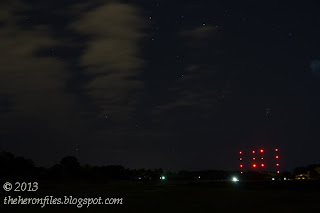Back on November 9th I took my final field trip as part of my
Master Naturalist basic training. I started the classes in early fall and have been taking 3 hours classes every week plus 4 field trips. Graduation is coming up the second week of December.

For our last field trip we took a boat trip aboard the Bea Hayman Clark out of Norfolk. The trip was run by the Chesapeake Bay Foundation. We spent the day traveling around the Elizabeth and Lafayette Rivers.
My adventure started even before boarding the boat. As I live much closer the downtown Norfolk than most of the others in class, I decided to drive to the boat directly instead of joining the car pool. Along my preferred route I first ran into an overpass that was closed for road work. The detour wasn't well marked so I had to wonder through a neighborhood for several minutes until my nav system got me back on course. Then five minutes later, the road was closed due to a car accident. Again, no detour. And the accident was close to a water crossing so the GPS kept trying to get me back on the same road. I eventually pulled out my paper map and found another crossing. And then, just as I see my destination, the lanes in the road start being blocked off. There was a 5K run that had the main roads in Norfolk closed for the morning. Luckily, I found a police officer who pointed me towards an open parking garage. But my 25 minute drive had taken 45 minutes.
 |
|
It was a surprisingly warm day, even out on the water. We went out the Elizabeth River to where it joins the Chesapeake Bay and stopped and talked about the bay and some of the troubles it is having: over-fishing, run-off, and summer algae blooms. We then headed up the Lafayette River and put out a trawling net and brought up a net full of fish. We then sorted the fish before doing some identification and discussion of the different species. We then returned all of them to the river. The shrimp was particularly interesting to me as I didn't realize how translucent they were.
 |
| The trawling net ready for deploying |
 |
| A rather large flounder that we caught |
 |
| Pulling up the oysters |
After lunch we pulled up some oysters. When the English first arrived on the Chesapeake Bay oysters were common throughout the bay. An oft-quoted factoid is that the oysters in the 1600's could filter all of the bay's water in three to four days. It now takes almost a year. Much of Hampton Roads was built on the oyster industry, even into the twentieth century. The CBF is working to restore oyster reefs by having people grow them for a year in protected waters and then taking them out to join an established reef. In fact, my wife and I did that several years ago. But in what we pulled up, only about a quarter of them were living. One of the other students found this collection of oyster shells and barnacles that is reminiscent of of another animal that likes the water (but not salty).
 |
| A "froggy" oyster shell |
Our final stop was looking at crabs. For this one I had the opportunity to pull up and crab pot, remove the crabs and rebait the pots. Again, we studied the crabs we found before returning them to the waters.
All in all, it was an enjoyable and educational trip. There weren't as many birds as I was expecting but I've never had a chance to get such insight to the underwater live.
 |
| Our captain with a female Blue Crab |




















































